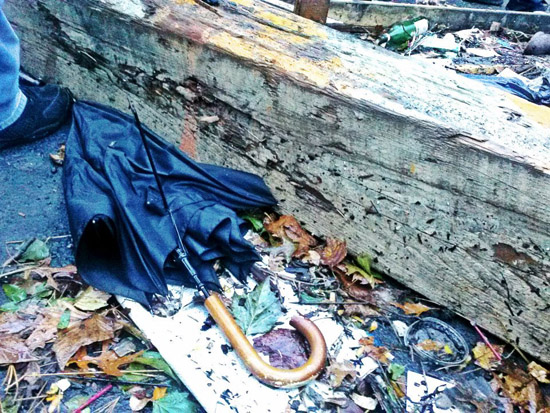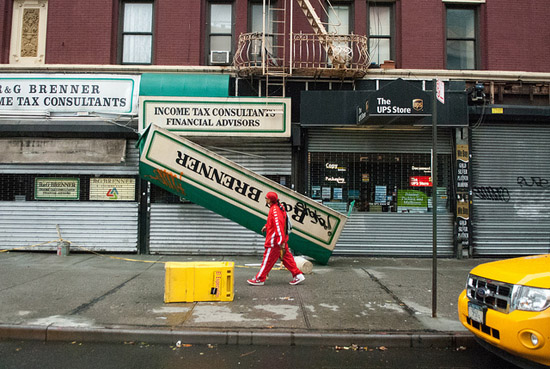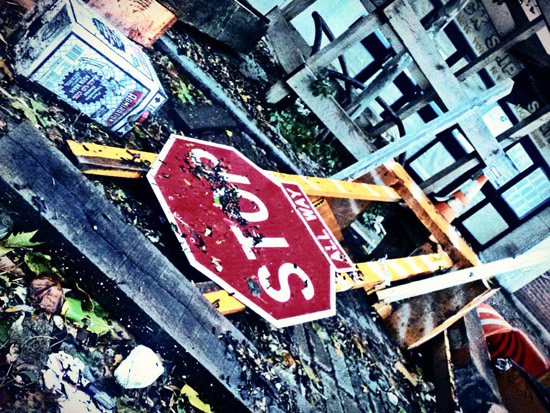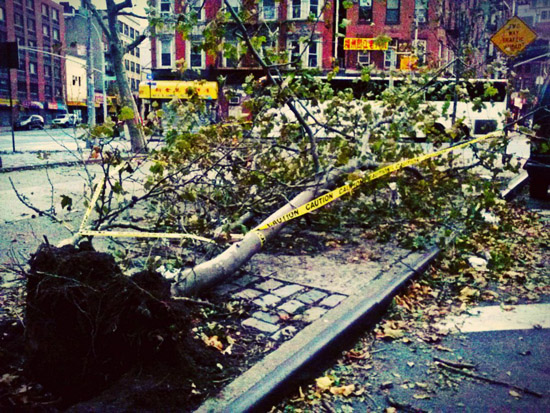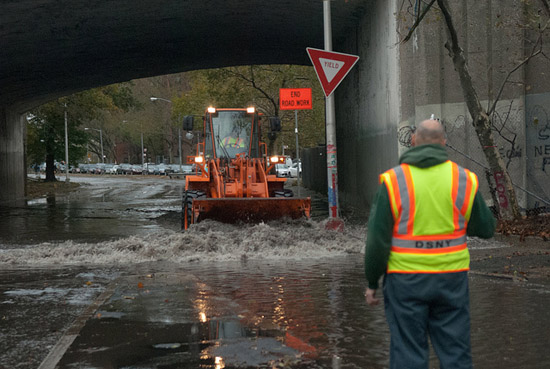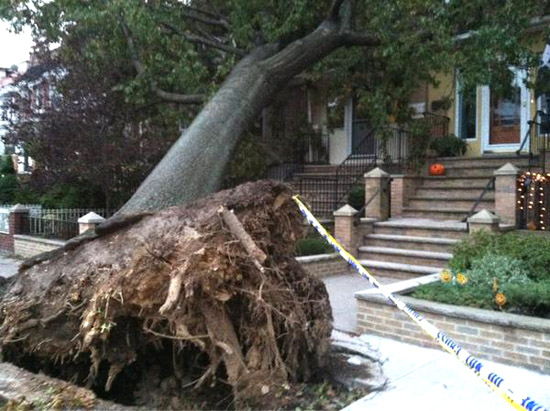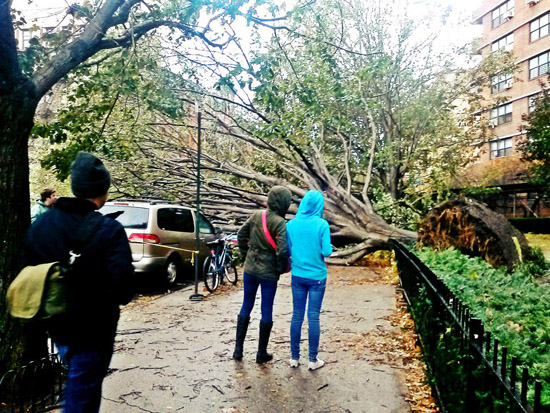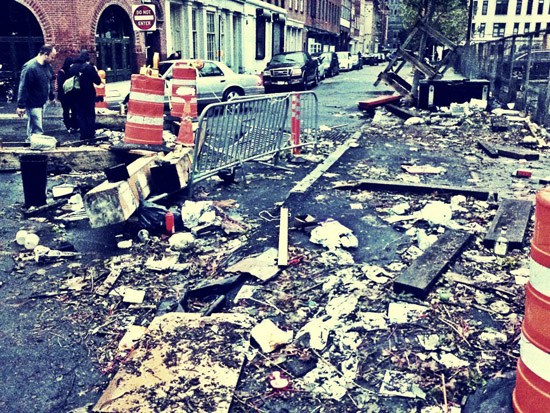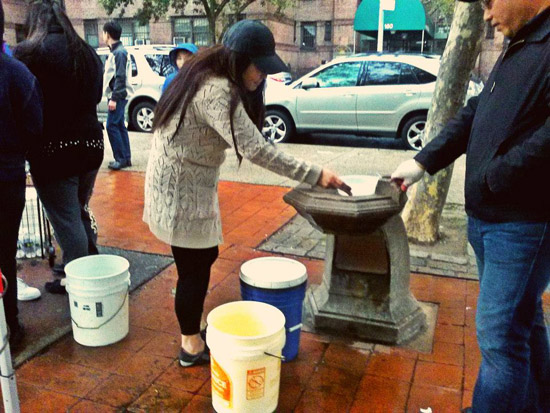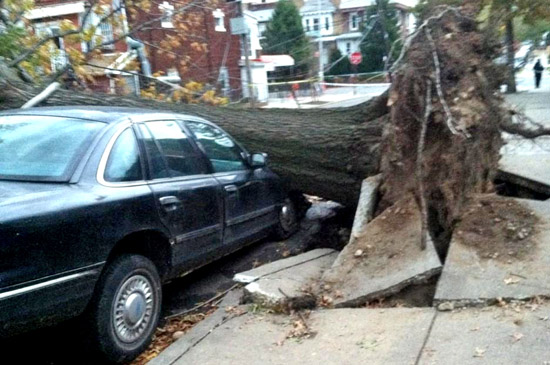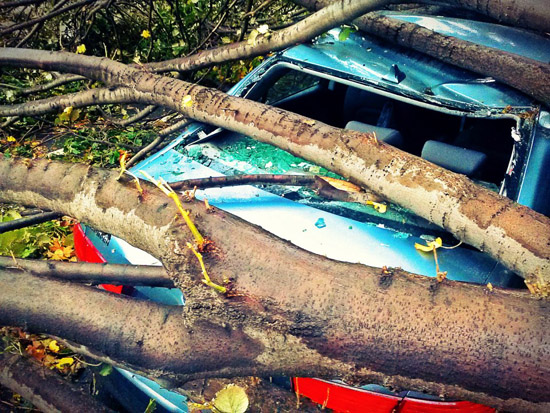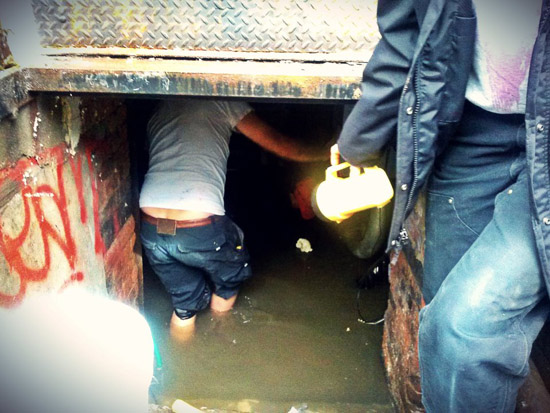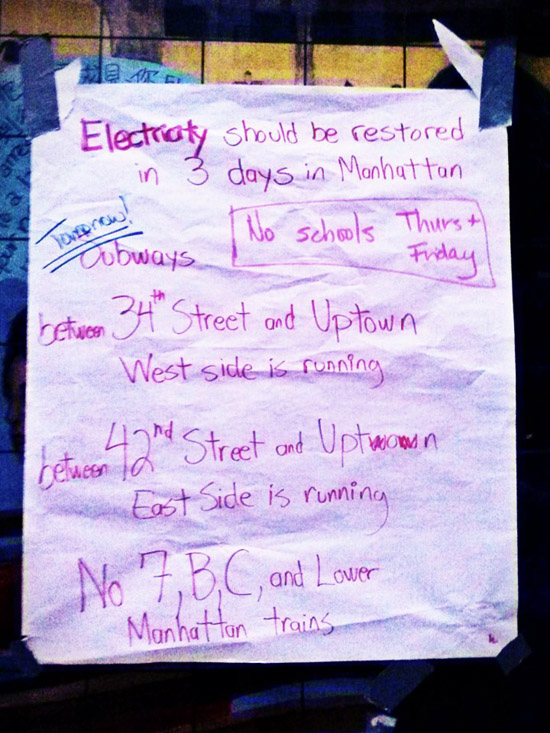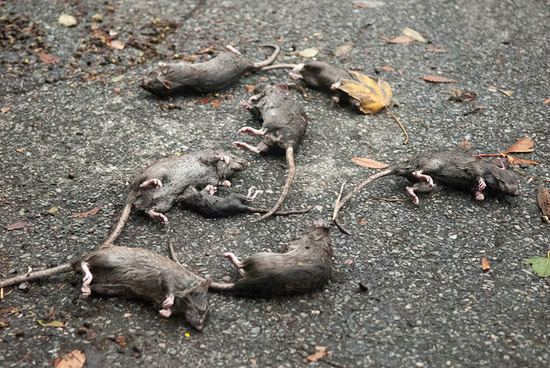
Blood And Thunder: New York After Hurricane Sandy1
Posted In Activism,Blog,Favorites,Love,Politics,Relationships,Society
by Laurie Penny a.k.a. @PennyRed

In the forty-eight hours since I landed in the United States, flying into storm-torn Brooklyn just days after a bunch of cars floated down Wall Street, nobody has mentioned the election to me once. You know, the presidential election, the one that’s happening in – what is it, three days? Right now, New Yorkers have more important things on their minds.
Access to food, fuel and electricity, for a start. People who do have these things are opening up their homes to friends and strangers who don’t. Across the city, volunteers are packing cars and heading to the disaster zones of Red Hook and the Rockaway, as well as to Staten Island, the borough worst hit when Hurricane Sandy battered through to flatten homes and devastate lives.
Like I said, nobody’s talking about the election. The island I always privately think of as Starship Manhattan spent days cut off from the rest of New York state, all of the lights out for days under 34th street, basements choked with brackish water, old people stranded in their homes. There’s an actual crisis taking place: houses have been destroyed, lives lost. The eighteen-month media circus that passes for representative politics in this country seems worlds away from the women in Staten Island weeping in front of the remains of their family homes on the nightly news.
With it being practically impossible for anyone without a car and a full tank of fuel to cross the city, I’ve just come back from volunteering down the street at the Williamsburg Church emergency blood drive. Right now New York is in a blood crisis. When the hospitals were evacuated during the storm, there was no time to collect the blood left in storage banks when the power went out, and by the time they got everyone to safety, that blood had rotted. Now they need new blood desperately.
When me and my friend Veronica Varlow went down to the Church to open our veins for the cause, I was told that my tangy British blood was not acceptable because I might be riddled with mad cow disease (this from people who haven’t even read my Twitter feed). They did, however, need volunteers to help shepherd those donors who were waiting patiently in line for up to three hours to hand over pints of superior all-American hemoglobin. So, I pinned on a badge and spent a few hours buzzing around filling out forms for people, cleaning tables and chairs, handing out snacks and tea and generally making myself useful. Even doing something so small to help the people helping to rebuild the city felt powerful.
Blood: when disasters happen, I’m always struck by the readiness with which people queue up to restock the banks of blood, platelets, and plasma. In the days after September 11, 2001, the donation centers had to start turning people away, and indeed, here at the Williamsburg Church we’re doing the same thing; with the donation line already thirty people deep, we’re running around with sign-up sheets where eager donors can leave their name and number in case we need more blood tomorrow.
There’s something so tender about that impulse. Sure, it says, we could raise money or go and help pump water out of basements in the Lower East Side, but wouldn’t it be simpler just to give you this part of my own body that was pumping in my heart five minutes ago? I’m pretty sure that if the New York blood centre were to put the call out tomorrow asking people to donate a pound of flesh cut from the chest closest to the heart because someone stranded on Staten Island needs it, there’d be plenty of volunteers, and not all of them would be kinky Shakespeare fetishists.
When there’s a crisis on, people want to help. Running around with the snack basket I was reminded of the floods of volunteers who gave their time, money and expertise to the Occupy camps last year. Practical anarchism. Everyone so keen to do whatever they could to help. Not just the kids from all over the country who kicked in their lives to sleep in the cold and be arrested multiple times in the name of a better future, but the shop owners who shipped out their spare produce. The trained nurses who turned up to administer basic medical care to those who had none. The parents who donated freshly-baked pies and soups to the kitchens. The librarians and academics who created an enormous library that, almost a year ago, I watched the NYPD rip apart and hurl into dumpster trucks, just because it was messing up their nice clean corporate dead-zone.
It’s no accident that the original Occupy Wall Street organizers were among the first to set up and co-ordinate volunteering efforts across New York. The group, which has drifted in recent months, immediately set about organizing teams and transportation to the worst-hit areas. The Zuccotti Park protest camp which was evicted last November and the enormous post-Sandy volunteer effort going on this week are different expressions of the same thing: overwhelming human response to crisis.
Crisis is what people in the United States have been living with for at least four years. Active emergency, turning people out of their homes and into the cold, destroying lives. It’s not crass to compare a climate disaster to a juddering crisis of capitalism, because the two are connected, not least because those most responsible are also those most likely to be snugly tucked away in gated compounds shrugging their shoulders when the storm hits. Like the crash, Hurricane Sandy hit the poorest hardest, smashing through Staten Island and Rockaway while the lights stayed on on the Upper East Side.
Nobody expected it to be quite this bad. Last year’s Hurricane Irene was bearable for most. But what I’m seeing here, at least in Brooklyn where I’ve been stuck for two days, is a city coming out of a six-month paralysis: finally, there’s a concrete task that people can put their hands to.
Sarah Jaffe’s brilliant piece at Jacobin draws attention to Rebecca Solnit’s work on the communities that arise in disaster zones:
“There’s a particular opportunity for mutual aid in the void in the aftermath of disaster, particularly in a neoliberal state whose safety net has been shredded, where the state simply isn’t there and people step up to take care of each other (not “themselves” as our libertarian friends would have it, and not the rich handing out charity as Mitt Romney wants you to believe, but communities in solidarity). The idea of mutual aid was at the foundation of Occupy as much as the much-debated horizontalism and the opposition to the banks.”
Volunteerism, of course, can be regressive as well as radical. I am reminded of those “broom armies” in London in the middle of the August riots last year; the sea of white, middle-class faces holding up brooms they’d brought to unfamiliar areas of the city, the sweet intention to mop up after a disaster tempered by the idea that the kids from deprived areas who came out to fight the police could just be swept away like so much filth. Like any desperate human impulse, volunteerism can easily be co-opted, twisted into something violent, calcifying.
Greece, where I spent part of my summer documenting the human effects of economic collapse, isn’t the only developed country where people have been living in crisis for so long they are starting to numb down and accept it. As Imara Jones pointed out in The Guardian today, 50 million Americans, the same number as those in the states hardest-hit by Hurricane Sandy, are living in acute poverty, and nobody in the presidential race has deigned to talk to or about them, despite the fact that they also have votes.
How do we respond to crisis when crisis has become status quo? That’s the question facing the entire developed world this year, and neither of the men jostling to lead the nominally free world appear to have any sort of answer. The Occupy Sandy operation is not an answer either, not even the shadow-play of an answer, but it is deeply radical and compassionate. That means someone’s probably going to try to shut it down reasonably soon, especially if it continues to provide food and assistance to the needy after the floodwaters have receded. A community response to immediate external crisis can be spun as good PR for an administration, but a community response to structural, internal crisis is just embarrassing. In every case though, the most dangerous thing you can do in any crisis – the absolute worst thing you can possibly do – is sit at home and accept it.
Back to blood. Funny thing about blood: until the 1970s, America used to buy it. Blood donation, as the United States quickly discovered, is not something you want to inject with a market incentive when you have to juggle things like infection risks and supply shortages. All that changed when Richard Titmus’ book The Gift Relationship: From Human Blood to Social Policy was published in 1971, explaining why the values of public service beat the private market every time when it comes to social care. The private market in American blood was regulated until it became something like the British voluntary model – people coming in to open their veins for a biscuit and a cup of coffee, just because somebody else needs their blood more than they do. Quite a lot of my job at Billyburg church today was handing out packets of Oreos to younguns waiting in line to do just that – I still have no damn idea who donated those biscuits – and telling the people massing at the door that no, we have all the blood we need for today, thank you, come back tomorrow.
“There is in the free gift of blood to unnamed strangers no contract of custom, no legal bond, no functional determinism, no situations of discriminatory power, domination, constraint or compulsion, no sense of shame or guilt,” wrote Titmus. “In not asking for or expecting any payment of money, these donors signified their belief in the willingness of other men to act altruistically in the future.” There is still enough blood beating in the cynical hearts of New Yorkers to pound out an immediate, compassionate response to crisis. Today that gives me hope.
Occupy Sandy Relief information here can be found at interoccupy.net/occupysandy/ – a website put together by the good folks at OWS, which contains all you need to know about what you can do to help. Click here for the NYC Blood Drive list of donation centers and opening times.
Laurie Penny is a journalist, feminist, and political activist from London. She is a regular writer for the New Statesman and the Guardian, and has also contributed to the Independent, Red Pepper, and the Evening Standard. She is the author of Meat Market: Female Flesh Under Capitalism (2011) and Discordia (2012). She has presented Channel 4’s Dispatches and been on the panel of the BBC’s Any Questions. Her blog, “Penny Red“, was shortlisted for the Orwell prize in 2010.



